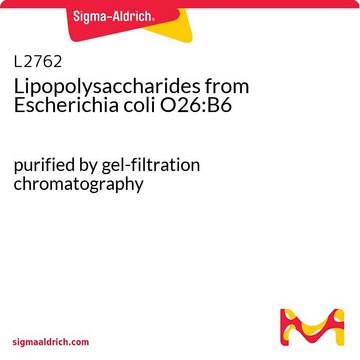L2262
Lipopolysaccharides from Salmonella enterica serotype typhimurium
purified by gel-filtration chromatography
Synonym(s):
LPS
Sign Into View Organizational & Contract Pricing
All Photos(2)
About This Item
Recommended Products
biological source
Salmonella enterica (Serotype typhimurium)
Quality Level
form
lyophilized powder
purified by
gel-filtration chromatography
impurities
<1% Protein
color
white to faint yellow
solubility
water: 0.90-1.10 mg/mL, hazy to turbid, colorless to faintly yellow
shipped in
ambient
storage temp.
2-8°C
Looking for similar products? Visit Product Comparison Guide
General description
This product is extracted from Salmonella typhimurium and purified by gel filtration. The source strain is ATCC 7823.
Application
Lipopolysaccharides (LPSs) are characteristic components of the cell wall of Gram-negative bacteria. LPS and its lipid A moiety stimulate cells of the innate immune system by the Toll-like receptor 4 (TLR4), a member of the Toll-like receptor protein family, which recognizes common pathogen-associated molecular-patterns (PAMPs).
Biochem/physiol Actions
Lipopolysaccharides (LPS) are localized in the outer layer of the membrane and are, in noncapsulated strains, exposed on the cell surface. They contribute to the integrity of the outer membrane, and protect the cell against the action of bile salts and lipophilic antibiotics.
Preparation Note
The product is soluble in water (5 mg/ml) or cell culture medium (1 mg/ml) yielding a hazy, faint yellow solution. A more concentrated, though still hazy, solution (20 mg/ml) has been achieved in aqueous saline after vortexing and warming to 70-80 oC. Lipopolysaccharides are molecules that form micelles in every solvent. Hazy solutions are observed in water and phosphate buffered saline. Organic solvents do not give clearer solutions. Methanol yields a turbid suspension with floaters, while water yields a homogeneously hazy solution.
Other Notes
To gain a comprehensive understanding of our extensive range of Lipopolysaccharides for your research, we encourage you to visit our Carbohydrates Category page.
related product
Product No.
Description
Pricing
Storage Class Code
11 - Combustible Solids
WGK
WGK 3
Flash Point(F)
Not applicable
Flash Point(C)
Not applicable
Choose from one of the most recent versions:
Already Own This Product?
Find documentation for the products that you have recently purchased in the Document Library.
Customers Also Viewed
Jia Lin Ren et al.
Scientific reports, 8(1), 429-429 (2018-01-13)
Inflammation is in a wide spectrum of retinal diseases, causing irreversible blindness and visual impairment. We have previously demonstrated that Green Tea Extract (GTE) is a potent anti-inflammatory agent for anterior uveitis. Here we investigated the anti-inflammatory effect of GTE
Alun C Kirby et al.
Infection and immunity, 72(11), 6390-6400 (2004-10-27)
The location and functional properties of antigen-specific memory T-cell populations in lymphoid and nonlymphoid compartments following DNA immunization or infection with Salmonella were investigated. Epitope-specific CD8+ -T-cell expansion and retention during the memory phase were analyzed for DNA-immunized mice by
Rui F D S Mesquita et al.
Molecular and cellular biology, 34(4), 574-594 (2013-12-04)
The pathways which regulate resolution of inflammation and contribute to positive remodeling of the myocardium following injury are poorly understood. Here we show that protein kinase C epsilon (PKCε) cooperates with the phosphatase calcineurin (CN) to potentiate induction of cardioprotective
Rossella Paolillo et al.
International immunopharmacology, 9(11), 1265-1271 (2009-08-04)
Probiotics, defined as live microbial food supplements which improve the health of the host, have obtained increasing medical importance. In the intestine they may prevent the overgrowth of pathogenic bacteria, increase the resistance of the gut to invasion by pathogens
Varkha Agrawal et al.
Biology of reproduction, 91(5), 119-119 (2014-09-26)
Platelet-activating factor (PAF), a potent phospholipid activator of inflammation that signals through its cognate receptor (platelet-activating factor receptor, PTAFR), has been shown to induce preterm delivery in mice. Toll-like receptors (TLRs) are transmembrane receptors that mediate innate immunity. We have
Our team of scientists has experience in all areas of research including Life Science, Material Science, Chemical Synthesis, Chromatography, Analytical and many others.
Contact Technical Service

